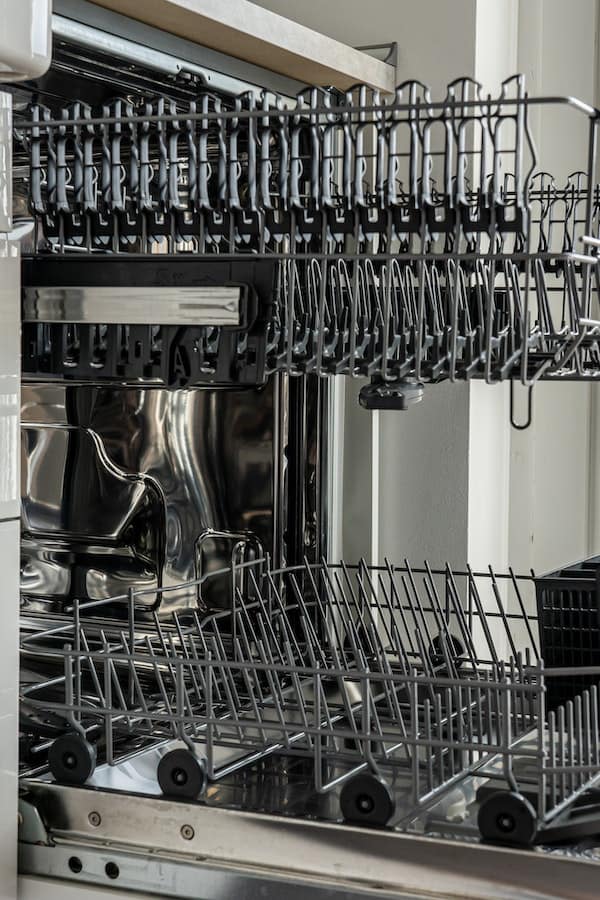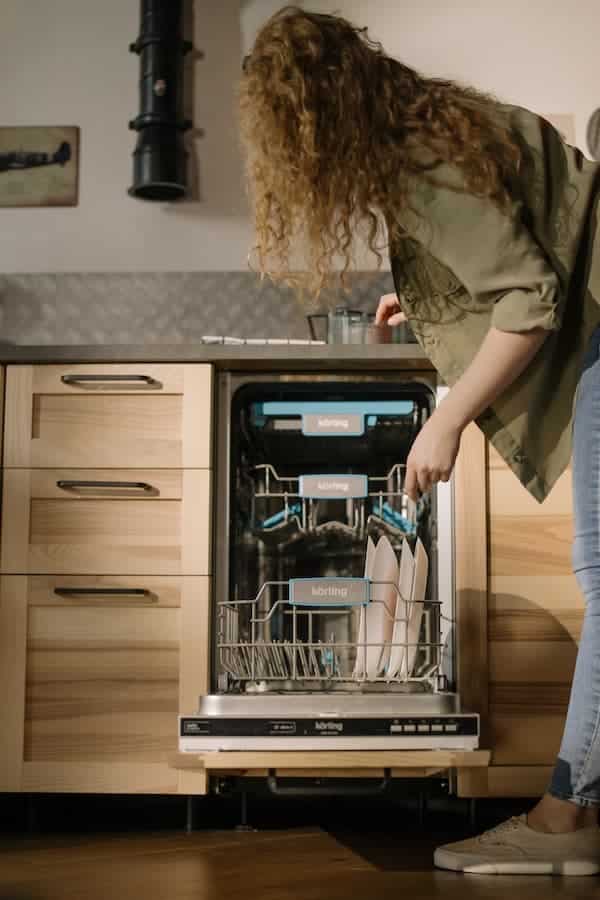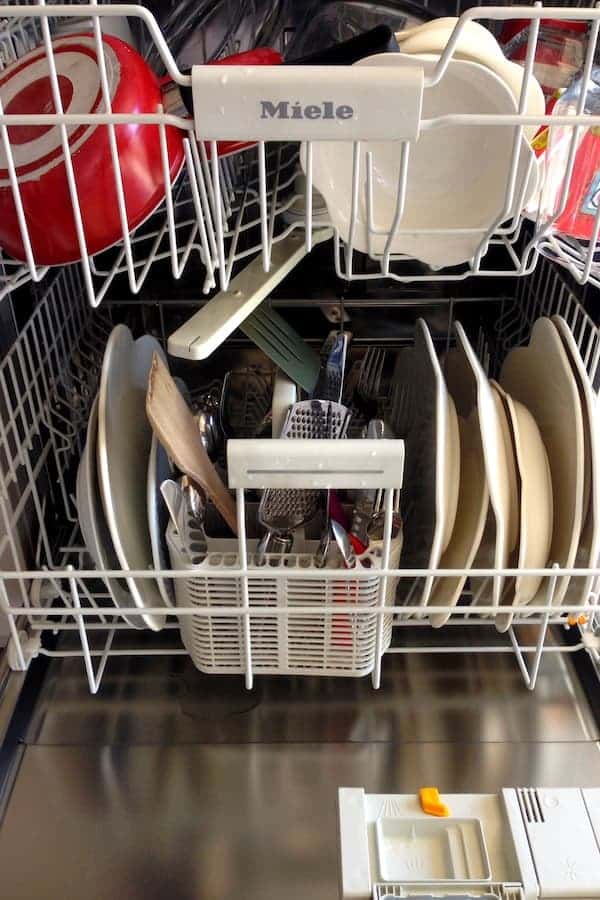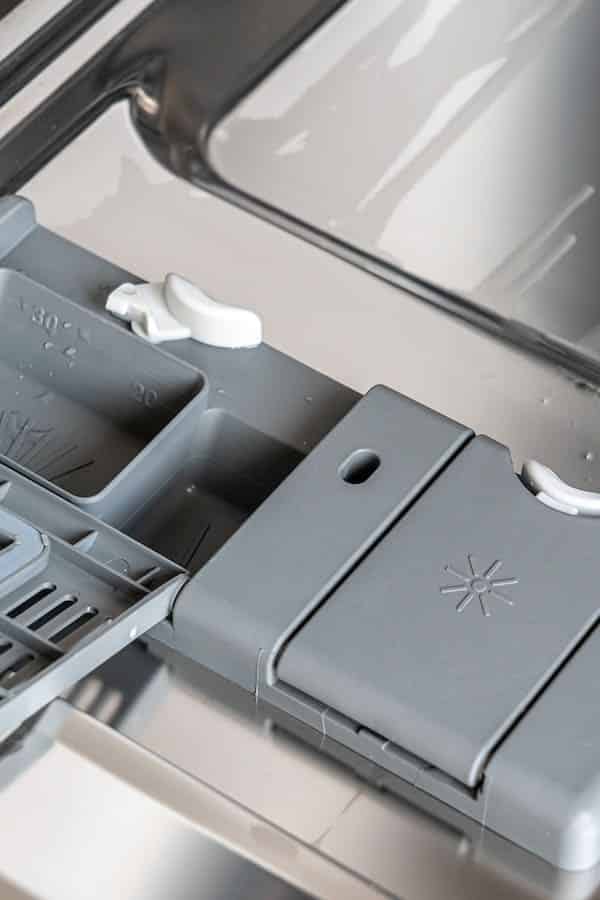We know the feeling. It’s been a rough day and all you want is to relax at home with a glass of wine, some Netflix, and a clean kitchen full of sparkling dishes.
But then you open your dishwasher to find that the dispenser is broken, and it won’t dispense soap!
Suddenly you must consider an expensive repair, which takes time, money, none of which you want to spend. This is one of my worst nightmares as well as many other people’s.
Luckily, there are some simple ways to make sure your dishwasher continues to work efficiently even your dispenser stops working or the lid breaks. Keep reading to find out our top tips…
There may be affiliate links in this article. You can read more about this in my disclosure.
How does your dishwasher work?

You may be wondering how a dishwasher works when the soap dispenser isn’t working. First, and this may be obvious, you fill the dishwasher with dirty dishes and place them in the machine, making sure you don’t overfill it, or the plates won’t clean properly.
Then, you turn on the machine, and at that moment the water to starts to heat up. This hot water is then sprayed onto your dirty dishes with help from the turbine.
This is when the soap dispenser comes into play. As its name indicates it gradually dispenses the soap into the water, meaning it dissolves evenly and gets distributed around the dirty dishes.
If the dispenser breaks, you will find clumps of soap, dirty dishes or even a blocked dispenser. This is not ideal.
A broken dispenser ideally needs to be changed, but if you don’t have the time or money, you can follow these steps.
Why do dishwasher soap dispensers break?
The first thing to know about dishwasher soap dispensers is that they’re made of plastic. Plastic is generally susceptible to damage, especially when it comes in contact with food and chemicals.
The fragility of plastic means that if you have kids or pets, there’s a good chance your dishwasher soap dispenser will be broken by accident at some point. Sometimes even it can break during a wash cycle.
The second thing to know about dishwasher soap dispensers is that they get clogged with food. This can often happen when the plastic becomes worn down from use over time and extra bits of grime start getting caught inside the mechanism.
Thirdly, if you have an older machine and the parts were made from poor quality materials, then you may experience problems—this can also cause your dishwasher soap dispenser to break down and need replacing!
What will you need?
Depending on which of the following point you will be using you will need:
[amazon box=”B092LM17GM,B095Z325K4,B00CC6XSSQ,B08N5959M9,B09P4PQL8G,B0B2TDH24J, B07YWHTV2D,B08HPGG798″ template=”list”]First, try to clean the dispenser with vinegar. This may solve your problem.
If you have recently noticed that your dishwasher’s soap dispenser is broken, you might be wondering if there’s anything you can do to fix it.
The good news is that there are a few different ways to get the job done. Here are some methods for cleaning your dishwasher’s soap dispenser:
Vinegar is a great cleaning agent, so it can remove any dirt or grime that may be stuck in the dispenser. Start by pouring some vinegar over the dispenser.
Use a cotton swab or toothpick to clean out any gunk or food debris inside of your soap dispenser. Another good option is a toothbrush, the little bristles clean out the cracks nicely.
Be careful not to damage any parts while using these tools. Once you’ve tried cleaning it, try closing it and running a cycle.
You’ll soon find out if it did the trick. If the dishes still come out mucky, try the following tips.
If this does not work, you can pour your soap directly into the broken dispenser without closing the lid.
If this does not work, you can pour your soap directly into the broken dispenser without closing the lid. Use the same amount of soap you usually would.
You may want to use a funnel if you are worried about spilling or making a mess. Instead of using tablets, try and use liquid soap, this will help it to dissolve.
Again, try running a full cycle and keep an eye out for dirt once it finishes.
[amazon box=”B07HKR2QP9″ template=”vertical”]You can also put your soap in a bowl on the bottom of your dish rack
Another great option is to directly put your soap in a bowl on the bottom of your dish rack. Again, this method works better with liquid soap instead of tablet.
The next time you run the dishwasher, load it up with dirty dishes and place the empty bowl with soap in it on the bottom rack so that it will be submerged in water. It doesn’t have to be a big bowl, just make sure water will easily get into it to dissolve the soap.
Anything with a narrow opening won’t do. Close the lid and let ‘er rip!
If you do these methods, you will clean your dishes, but it may not be as effective
You’ll soon see that these methods are a great option for emergencies. Yes, they do the trick, but you won’t get the same clean sensation as with a working soap dispenser, they are slightly less effective.
This is mainly due to the fact that the soap isn’t evenly distributed and dissolved in the water. Saying that, they’re worth a try and will help you get out of a sticky situation.
There are a few other options though, keep on reading to find them out…

You can buy an automatic tablet dispenser which will serve as a good replacement
A great alternative, if you’ve unsuccessfully tried the steps mentioned above, is to buy an automatic tablet dispenser. These work in the same way as a usual dispenser, the only difference is you place it in the dishwasher, on the rack, with the plates.
This is a step up from the other options, and will work better, that being said, take into account that the main disadvantage of this option is that they do tend to be quite pricey.
Once you find a suitable automatic dishwasher soap dispenser online or at your local hardware store, you do not need to remove your old dispenser as it is placed in a different spot.
Make sure you read the instructions on the packet to ensure optimal cleanliness as all products have their own requirements. These dispensers will work with most dish soaps, although some only use tablets.
If all else fails, this is how to completely replace your soap dispenser

If you’re unable to get your soap dispenser working by cleaning it, and the previous point don’t do the trick, the best thing to do is buy a new one and replace it.
Do be careful when doing so, as it is tricky, and you don’t want to damage your dishwasher further.
To replace the broken soap dispenser:
- Turn off the dishwasher at the socket
- Remove the old dispenser. There are two ways that you can do this: Either by disassembling your dishwasher or by unclipping it from its mounting bracket.
- Once removed, set aside the old soap dispenser and any other small parts that came with it so they don’t get lost while you’re installing your new one.
- Install the new dispenser into place. Make sure it’s securely attached before reconnecting any hoses or wires connected to it
- Check your instruction manual for instructions and please contact a professional if you are unsure on how to do so.
Once done, reassemble your dishwasher following these steps in reverse order until all pieces have been secured back into place—you may want some help from another person if there are particularly tricky parts involved in this step of the process.
You can now run through another cycle without worrying about getting detergent on yourself anymore!

Conclusion
If you have a dishwasher, chances are that you know how frustrating it can be when your soap dispenser stops working. Plastic isn’t the strongest of materials so they can often snap, break or not close.
The good news is that there are many ways to get around this problem and continue using your dishwasher without having to spend any money on buying new parts or hiring someone else to repair it. Before panicking, try cleaning it, to make sure no gunk is in there.
If this doesn’t work, try these steps out and we’re sure that your plates will be sparkling in no time at all, and you can continue with your day!



